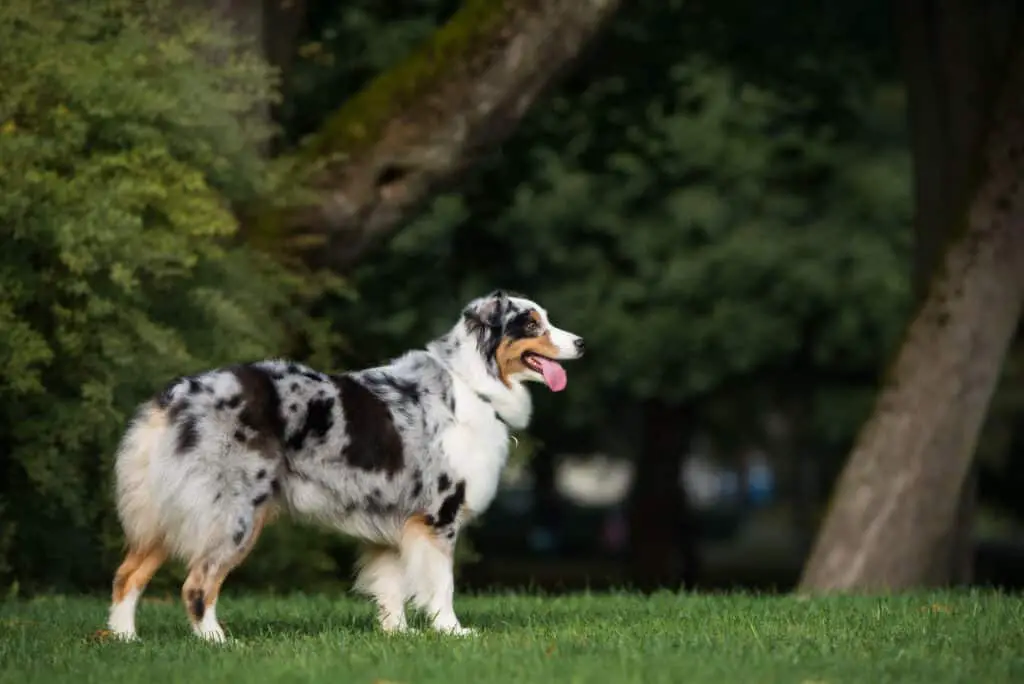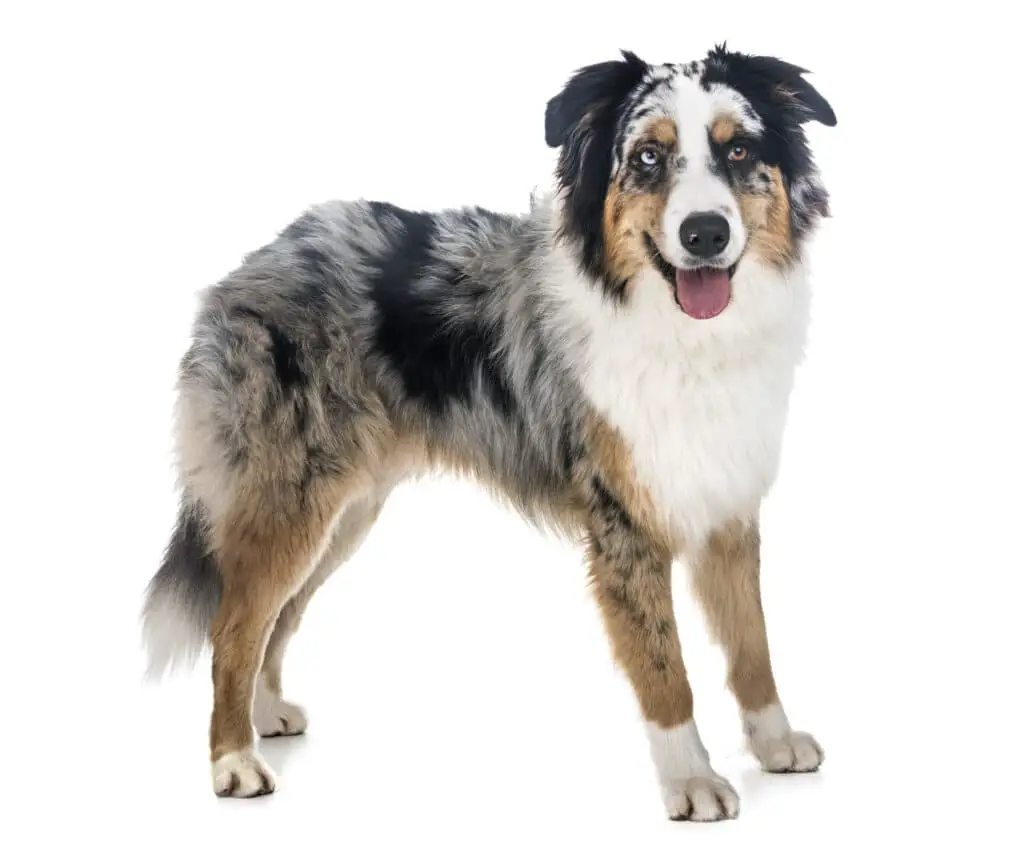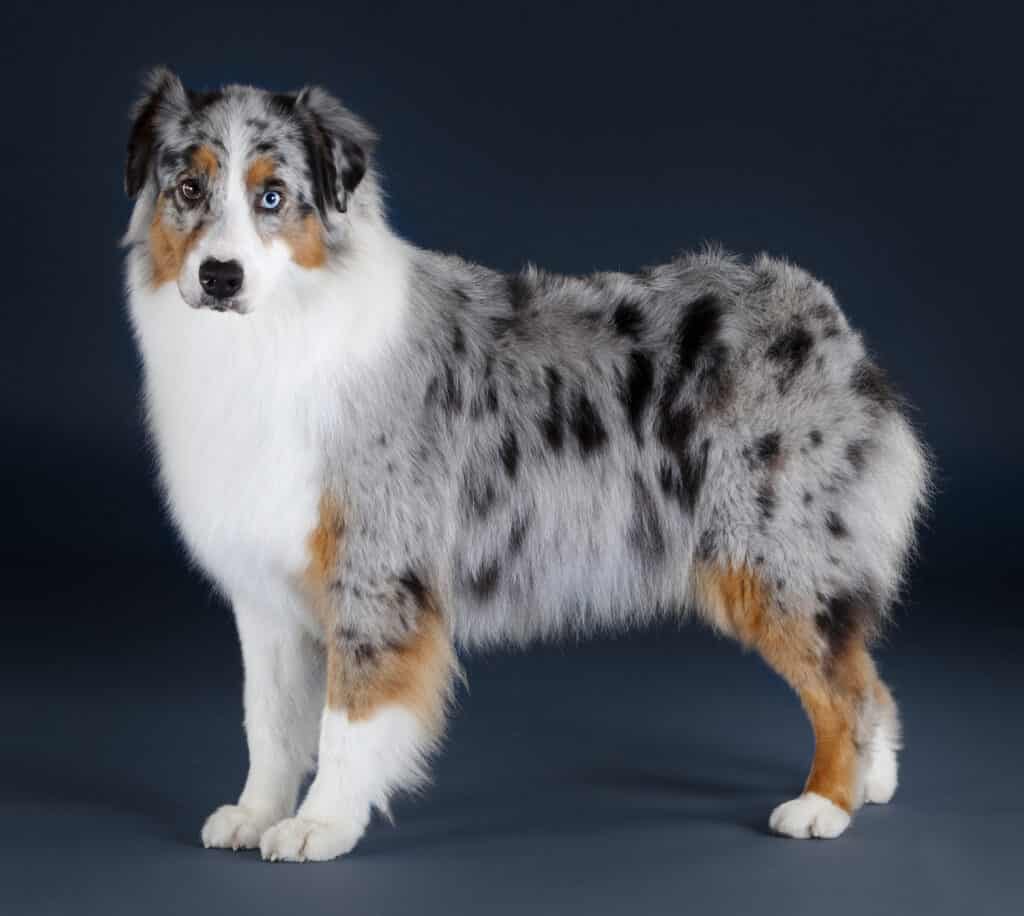Our website is supported by our users. We sometimes earn money when you click an affiliate link and make a purchase. This is at no extra cost to you and helps us to create quality content. Thank you for your support. For all that have shown us such wonderful support, we thank you from the bottom of our hearts!
If you’re looking for a unique and stunning dog breed, the Blue Merle Australian Shepherd might be just what you’re looking for. This breed is known for its striking coat, which is a combination of white, black, gray, and blue hairs.
Blue Merle Aussies are highly sought after because they aren’t as common as solid-coated Aussies, and their coat color creates an aesthetically pleasing effect.
One thing to keep in mind if you’re considering a Blue Merle Aussie is that they may be more expensive than other Aussies. This is because they’re in high demand due to their unique appearance. However, if you’re willing to pay a higher price, you’ll be getting a dog that is not only beautiful but also intelligent, loyal, and highly trainable.
In fact, Australian Shepherds are often used as working dogs on farms and ranches because of their intelligence and ability to learn quickly.
Breed History of the Blue Merle Australian Shepherd
This pooch is a popular dog breed among people who keep livestock and those with active lifestyles. In this section, you will learn about the origin of the Australian Shepherd and development of this breed.
Origin
Contrary to what its name suggests, the Australian Shepherd breed did not originate in Australia. Its roots can be traced back to the Basque region of Europe, where it was used by shepherds to herd sheep. Later, the breed was introduced to Australia, where it continued to be used for herding livestock.
In the 19th century, the breed was introduced to the United States, where it gained popularity among ranchers and farmers. The breed’s intelligence, loyalty, and herding instincts made it an excellent working dog.
Development
The development of the Blue Merle Australian Shepherd is not well documented, but it is believed that the breed was developed by crossing various herding breeds, including the Border Collie, with dogs that were brought over from Australia.
The breed’s distinctive blue merle coat is the result of a genetic mutation that causes the coat to have a marbled or speckled appearance. The breed’s striking appearance and herding abilities have made it a popular choice for both working and companion dogs.
Today, the Blue Merle Australian Shepherd is recognized by both the American Kennel Club and the
United Kennel Club and is a beloved breed among dog owners worldwide.

Physical Characteristics of the Blue Merle Australian Shepherd
When it comes to the Blue Merle Australian Shepherd, there are several physical characteristics that make this breed unique. For breeding there must be at least one merle parent with the blue merle gene. Here are the key characteristics that you should know about:
Height
The height of a Blue Merle Aussie can vary depending on the gender. Females can grow to be around 18 to 21 inches (46 to 53 cm) while males can grow slightly taller at 20 to 23 inches (51 to 58 cm).
Weight
The weight of a Blue Merle Aussie can also vary depending on the gender. Females typically weigh between 40 to 55 pounds (18 to 25 kg) while males can weigh between 50 to 65 pounds (23 to 29 kg).
Coat
The coat of a Blue Merle Aussie is medium in length and has a double-layered texture. These dogs have unique blue merle coats that are a combination of white, black, gray, and blue hairs. The coat can be straight or slightly wavy and is waterproof and weather resistant.
Coat Color
As the name suggests, the Blue Merle Australian Shepherd has a blue merle coat color. This is a type of genetic coat pattern that is very common in this breed. The blue merle coat is characterized by a marbled or speckled merle pattern with different color than just the tan markings.
They have patches of blue, gray, black, and white fur. Some even have copper points which means they have bits of reddish brown mixed into their coat.
Their eye color can vary as well. They can have brown eyes or amber eyes. But it’s really stunning to see an Australian Shepherd with ghostly blue eyes like a Siberian Husky.
Lifespan
The lifespan of a Blue Merle Aussie is typically between 12 to 15 years.
Overall, the Blue Merle Australian Shepherd is a beautiful and unique breed with several physical characteristics that set it apart from other breeds.
Whether you are considering getting a Blue Merle Aussie or simply want to learn more about this breed, understanding its physical characteristics is an important first step.

Temperament and Training of the Blue Merle Australian Shepherd
The Blue Merle Australian Shepherd is a highly intelligent and active breed that requires plenty of exercise and mental stimulation.
One of their defining personality traits are super high energy and they excel at dog sports including herding, agility, dock diving/dock jumping, obedience, tracking, frisbee and flyball.
They are loyal and affectionate dogs that make great family pets, but they also have a strong herding instinct, like border collies, that can lead to nipping and chasing behaviors if not properly trained.
Exercise
These are active dogs that require plenty of exercise to stay healthy and happy. This is the type of dog that enjoys running, hiking, and playing games like fetch, and they excel in activities like agility and obedience training.
They are a good fit to dog owner’s with with an active lifestyle. Aim to provide your Blue Merle Australian Shepherd with at least 60 minutes of exercise every day, but keep in mind that they may need more if they are particularly active or working dogs.
Training
Training is essential for Blue Merle dogs, as their high intelligence and herding instincts can lead to destructive behaviors if left untrained. Positive reinforcement training methods work best with this breed, as they respond well to praise and rewards.
Consistency is also key when training a Blue Merle Australian Shepherd, as they can become stubborn if they sense any inconsistency or ambiguity in their training.
Socialization is also important for the Blue Merle Australian Shepherd, as they can become wary of strangers if not properly socialized from a young age. Expose your Blue Merle Australian Shepherd to a variety of people, animals, and environments to help them develop into a well-rounded and confident adult dog.
In conclusion, the Blue Merle Australian Shepherd is a highly intelligent and active breed that requires plenty of exercise and mental stimulation. Proper training and socialization are essential for this breed, as they can become destructive and wary of strangers if left untrained.
With the right care and attention, the Blue Merle Australian Shepherd can make a loving and loyal companion for many years to come.

Health Issues of the Blue Merle Australian Shepherd Dog
As with any breed, the Blue Merle Australian Shepherd is prone to certain health issues. Here are some of the most common health issues you should be aware of if you’re considering adopting a Blue Merle Australian Shepherd:
Hip Dysplasia: This is a genetic condition that results in the improper formation of the hip joint. This can lead to arthritis and lameness. It is important to have your Blue Merle Australian Shepherd screened for hip dysplasia before adopting.
Eye Problems: Blue Merle Australian Shepherds are prone to a variety of eye problems, including cataracts, progressive retinal atrophy (PRA), and collie eye anomaly. Regular eye exams can help catch these issues early on.
Allergies: Blue Merle Australian Shepherds are prone to allergies, which can manifest as skin irritation, itching, and hair loss. Allergies can be caused by a variety of factors, including food, pollen, and dust. Your veterinarian can help you determine the cause of your dog’s allergies and recommend treatment options.
Epilepsy: Epilepsy is a neurological disorder that can cause seizures. While the exact cause of epilepsy is unknown, it is believed to be genetic. If your Blue Merle Australian Shepherd experiences seizures, it is important to seek veterinary care.
Cancer: Like all breeds, Blue Merle Australian Shepherds are at risk for developing cancer. Some of the most common types of cancer in dogs include lymphoma, osteosarcoma, and mast cell tumors. Regular veterinary check-ups can help catch cancer early on, which can improve the prognosis.
Congenital Deafness: When two merle dogs are bred together, a breed known as a double merle is produced. It makes no difference what kind of merle they are or what color they are. If two merle dogs are bred together, there is a one in four chance that one of the puppies may be born with a double merle coat pattern.
A double merle is a dog that has received two copies of the merle gene. Deafness typically affects both ears of a double merle that has white on or around the ears. The majority of double merles have this trait. It is possible for non-double merle Australian Shepherds with these markings to suffer from deafness in either one or both of their ears.
The absence of pigment in the inner ear is the root cause of the deafness.
Why do some Australian Shepherds have pigment cells in their inner ears while others do not? The absence of melanocytes is likely related to the presence of an excessive amount of white marks on the head.
Drug Sensitivity: Due to having something called the MDR1 mutation, many herding breeds are affected by drug sensitivity to certain drugs and all Australian Shepherds, even mini Aussies, are included in this list. The drugs that they are affected by are:
Acepromazine is a sedative used in dogs for calming and reducing anxiety.
Apomorphine induces vomiting and is used to empty a dog’s stomach of harmful substances.
Butorphanol is an opioid analgesic used for pain relief in dogs.
Doxorubicin is an anticancer drug used in dogs to treat various types of cancer.
Ivermectin is an anti-parasitic drug used to prevent and treat internal and external parasites in dogs.
Loperamide is an antidiarrheal medication used to treat diarrhea in dogs.
Milbemycin is an antiparasitic drug used to prevent and control internal and external parasites in dogs.
Moxidectin is an antiparasitic drug used to prevent and control internal and external parasites in dogs.
Paclitaxel is an anticancer drug used to treat various types of cancer in dogs.
Selamectin is an antiparasitic drug used to prevent and treat fleas, ticks, mites, and certain worms in dogs.
Vinblastine is an anticancer drug used to treat various types of cancer in dogs.
Vincristine is an anticancer drug used to treat various types of cancer in dogs.
It is important to note that while these health issues are more common in Blue Merle Australian Shepherds, not all dogs will develop them. Proper care, including regular veterinary check-ups, can help keep your Blue Merle Australian Shepherd healthy and happy.
Grooming Your Blue Merle Australian Shepherd
Grooming your Blue Merle Aussie Dog is an essential part of keeping your furry friend looking and feeling their best. Regular grooming will help you maintain your dog’s coat, skin, teeth, ears, and nails in good condition. Here are some tips on how to groom your Blue Merle Australian Shepherd.
Brushing
Brushing your Blue Merle Australian Shepherd should be done at least once a week to keep their coat healthy and shiny. Use a slicker brush to remove any loose hair and mats.
Start at the head and work your way down to the tail, brushing in the direction of hair growth. Another good tool is a undercoat rake. We like the Maxpower Planet Pet Undercoat Rake.
Be gentle and avoid pulling on the hair.

Bathing
Bathing your Blue Merle Australian Shepherd should be done every 6-8 weeks or when they get dirty. Use a dog-specific shampoo and conditioner to avoid drying out their skin. Wet your dog’s coat thoroughly and apply shampoo, working it into a lather.
A very useful tool that we love is the ELEGX Pet Grooming Massage Brush. It can help get the water and soap down through the undercoat for a deep thorough clean.
Rinse thoroughly and repeat with conditioner. Dry your dog with a towel or a hairdryer on low heat. It is important to thoroughly dry double-coated dogs because their fur can and will get matted.
Even if your dog gets wet outside of bathing, you will have to make sure they have been dried thoroughly.
Cutting Fur
If you are thinking of cutting the fur of your Blue Merle Australian Shepherd consider using a professional groomer.
The Australian Shepherd has a dense, double-layered coat that requires special care. Shaving or clipping a double coat too short can damage the coat and cause skin irritation.
This is the reason for regular brushing and to make sure that if your Aussie gets wet, that you thoroughly dry them.
Clipping or Grinding Nails
Clipping or grinding the nails of your Blue Merle Australian Shepherd should be done every 2-3 weeks to prevent overgrowth and discomfort.
Long nails can be uncomfortable for your dog, causing pain and impacting their mobility. Keep an eye on their nails and trim them regularly. You can use a nail clipper or grinder designed for dogs to ensure a safe and accurate trim. Don’t forget to clip the dewclaws too, as they can become ingrown if neglected.
Use a sharp clipper or grinder and be careful not to cut the quick, which is the part of the nail that contains blood vessels and nerves. If you accidentally cut the quick, apply styptic powder to stop the bleeding.
Brushing Teeth
Brushing the teeth of your Blue Merle Australian Shepherd should be done at least once a week to prevent dental problems.
Use a dog-specific toothbrush and toothpaste and be gentle when brushing. Focus on the back teeth, where plaque and tartar tend to accumulate.
Cleaning Ears
Cleaning the ears of your Blue Merle Australian Shepherd should be done every 2-3 weeks to prevent infections and ear mites. Use a dog-specific ear cleaner and a cotton ball or pad to wipe the inside of the ear flap and the ear canal.
Another great solution are these cleansing wipes. Be gentle and avoid pushing anything too far into the ear canal.

Owning a Blue Merle Australian Shepherd
If you are considering owning a Blue Merle Australian Shepherd, there are some things you should know before making a decision. Here are some key points to keep in mind:
Cost of Purchase and Maintenance
Blue Merle Australian Shepherds are highly sought after, so they can be more expensive than other colors. You can expect to pay anywhere from $800 to $2,500 for a puppy, depending on the breeder and other factors.
In addition to the initial purchase price, you will need to consider ongoing maintenance costs. Blue Merle Australian Shepherds require regular grooming to keep their coat healthy and shiny. They also need plenty of exercise and mental stimulation to stay happy and healthy. You may want to consider investing in special training classes or toys to keep your dog engaged and entertained.
Finally, you should be prepared for the possibility of medical costs. Like all dogs, Blue Merle Australian Shepherds can develop health problems over time. You should budget for routine veterinary care as well as unexpected expenses like emergency surgeries or medications.
Finding a Breeder or Shelter
If you decide to purchase a Blue Merle Australian Shepherd from a responsible breeder, it is important to do your research. Look for reputable breeders who have a good reputation and who can provide you with health clearances for the puppy’s parents. You may also want to ask for references from other satisfied customers.
Alternatively, you may want to consider adopting a Blue Merle Australian Shepherd from a shelter or humane society. This can be a great way to give a loving home to a dog in need while also saving money on the purchase price. Just be sure to ask plenty of questions about the dog’s history and temperament before making a decision.
Fun Facts
- Blue Merle Australian Shepherds are known for their striking coat patterns, which can include a mix of black, white, and gray.
- These dogs are highly intelligent and excel at obedience training and agility competitions.
- Blue Merle Australian Shepherds are often used as working dogs on farms and ranches, where they help herd livestock and perform other tasks.
- These dogs are known for their loyalty and affectionate personalities, making them great companions for families with children.
Frequently Asked Questions
What is the price range for Blue Merle Australian Shepherd puppies?
The price range for Blue Merle Australian Shepherd puppies can vary depending on the breeder, location, and demand. However, generally, you can expect to pay a higher price for a Blue Merle Australian Shepherd puppy as they are highly sought after and can be considered a rare color. According to The Smart Canine, the price for a Blue Merle Australian Shepherd puppy can range from $600 to $2,000.
Where can I find reputable Blue Merle Australian Shepherd breeders?
To find reputable Blue Merle Australian Shepherd breeders, you can start by checking with the Australian Shepherd Club of America. They have a list of registered breeders that you can contact. You can also research online and read reviews from other buyers to ensure that the breeder is reputable and ethical. It’s important to do your research and ask the breeder questions to ensure that the puppy comes from a healthy and well-cared-for lineage.
What is the difference between a Blue Merle and a Red Merle Australian Shepherd?
The main difference between a Blue Merle and a Red Merle Australian Shepherd is the color of their coat. A Blue Merle Australian Shepherd has a black coat with blue or gray patches, while a Red Merle Australian Shepherd has a red coat with lighter patches of red or white. It’s important to note that both Blue Merle and Red Merle Australian Shepherds can also have tan points and white markings.
Are Blue Merle Australian Shepherds rare?
While Blue Merle Australian Shepherds are not the rarest color, they are considered a sought-after and exotic color. This can make them more expensive and in higher demand than some other colors. However, it’s important to note that a reputable breeder should prioritize the health and temperament of the puppy over the color of their coat.
What is the temperament of Blue Merle Australian Shepherds?
The temperament of a Blue Merle Australian Shepherd is similar to other Australian Shepherds. They are intelligent, energetic, and loyal dogs that require plenty of exercise and mental stimulation. They are also known for their herding instincts and may try to herd children or other pets in the household. Early socialization and training are important to ensure that they develop into well-behaved and well-adjusted dogs.

The Bottom Line on the Blue Merle Australian Shepherd
If you’re looking for a loyal, intelligent, and active dog, the Blue Merle Australian Shepherd could be the perfect breed for you. Here are some key takeaways to keep in mind:
- Blue Merle Aussies are highly sought after due to their striking coat and unique color patterns. As a result, they can be more expensive than other Australian Shepherd varieties.
- These dogs are known for their high energy levels and require plenty of exercise and mental stimulation to stay happy and healthy. If you’re not prepared to provide them with enough activity, they may become bored and destructive.
- Blue Merle Aussies are intelligent and trainable, but they can also be independent and stubborn at times. Consistent training and socialization from a young age can help ensure that they grow up to be well-behaved and obedient.
- While Blue Merle Aussies are generally healthy and long-lived, they can be prone to certain health issues like hip dysplasia and eye problems. Regular vet checkups and preventative care can help keep your dog healthy and happy.
Overall, the Blue Merle Australian Shepherd is a wonderful breed for active and dedicated dog owners. With proper care and training, these dogs can make loyal and loving companions for many years to come.
Please read our Legal Disclaimer




